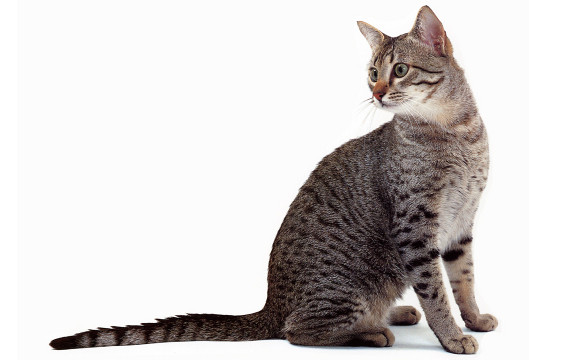Introduction
The Egyptian Mau is a remarkable and ancient breed known for its striking appearance and rich history. As the only naturally spotted breed of domestic cat, the Egyptian Mau has captured the hearts of cat enthusiasts worldwide.
History
The Egyptian Mau is believed to have descended from the cats worshipped by the ancient Egyptians. Evidence of these cats can be seen in ancient artifacts, including papyrus paintings and sculptures dating back to around 1100 B.C. These depictions often show spotted cats, believed to be the predecessors of the modern Egyptian Mau.
During the early 1900s, the Egyptian Mau was introduced to Europe, where enthusiasts in Italy, Switzerland, and France worked to develop the breed. However, World War II nearly led to its extinction. The breed was saved by Princess Nathalie Troubetskoy, who rescued some of the remaining cats and brought them to the United States in 1956. She established a cattery and worked to promote and preserve the breed. The gene pool was further widened in the 1980s and 1990s through the importation of additional cats.
Today, the Egyptian Mau is recognized by all major cat associations and has a dedicated following of breeders and enthusiasts.
Physical Characteristics
The Egyptian Mau is known for its unique appearance, particularly its striking spots, which can vary in size and shape. These spots provide excellent camouflage, reflecting the breed’s hunting prowess. The Mau’s face features distinctive tabby markings, including an “M” on the forehead and two “mascara” lines on the cheeks.
Coat and Colors:
- The coat is short and silky, coming in several colors: silver, bronze, and smoke.
- The spots are random and can be round, oblong, or a mix, providing a unique look for each cat.
Body and Eyes:
- The body is medium-sized, muscular, and graceful, with longer hind legs that contribute to the breed’s remarkable agility.
- The eyes are large, almond-shaped, and typically green, giving the Mau an expressive and exotic look.
Temperament and Personality
While the Egyptian Mau’s appearance initially attracts admirers, it is the breed’s temperament that often turns them into lifelong enthusiasts. The Mau is known for its loyalty and affectionate nature, forming strong bonds with its human companions. These cats are often described as reserved with strangers but fiercely loyal to their family.
Behavior:
- Egyptian Maus are playful and enjoy activities that mimic hunting. Fetch is a favorite game, reflecting their ancient hunting instincts.
- They are intelligent and curious, often seeking out interactive toys and engaging in problem-solving activities.
Vocalization:
- The breed is not overly talkative, but they will communicate their needs and feelings through a range of sounds, including chortling and melodious meows.
Health and Care
The Egyptian Mau is generally a healthy breed with a robust constitution. However, there are some considerations to keep in mind to ensure they remain in optimal health.
Health Concerns:
- Regular veterinary check-ups are essential to monitor for any genetic or common feline health issues.
- Maintaining a balanced diet and providing regular exercise will help keep your Mau in peak condition.
Grooming:
- The Mau’s short coat is relatively low-maintenance, requiring only occasional brushing to remove loose hairs and keep it shiny.
- Regular dental care, ear cleaning, and nail trimming are recommended as part of a comprehensive grooming routine.
Living with an Egyptian Mau
Owning an Egyptian Mau can be a rewarding experience. These cats thrive in environments where they receive plenty of attention and stimulation.
Activity Level:
- Egyptian Maus are active and enjoy having space to explore and play. Providing climbing structures and interactive toys will help keep them entertained.
Interaction with Children and Pets:
- The breed generally gets along well with children and other pets, especially if socialized from a young age. However, they may prefer the company of their human family over strangers.
Conclusion
The Egyptian Mau is a fascinating breed with a rich history and a unique set of characteristics that make it a wonderful companion. From its distinctive spotted coat to its loyal and playful nature, the Mau continues to enchant cat lovers around the world.
For those considering adding an Egyptian Mau to their family, it is essential to understand the breed’s needs and characteristics to provide a loving and suitable environment. With proper care, the Egyptian Mau can be a delightful and cherished member of any household.
FAQs about Egyptian Mau Cats
1. How long do Egyptian Maus live?
- Egyptian Maus typically have a lifespan of 12 to 15 years with proper care.
2. Are Egyptian Maus hypoallergenic?
- No, Egyptian Maus are not considered hypoallergenic, although some people with allergies may tolerate them better than other breeds due to their short coat.
3. Do Egyptian Maus require a lot of grooming?
- The breed’s grooming needs are minimal, requiring only occasional brushing to maintain their coat’s health and appearance.
4. Are Egyptian Maus good for families?
- Yes, Egyptian Maus can be excellent family pets, especially if they are well-socialized and given plenty of attention and interaction.
By understanding and meeting the needs of the Egyptian Mau, owners can enjoy a fulfilling relationship with this unique and captivating breed.

